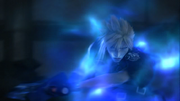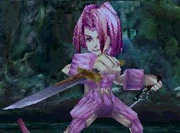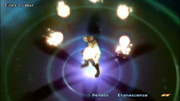Template:Featured article
Gabranth using Frost Purge in Dissidia Final Fantasy.
Limit Breaks, also known simply as Limits, are powerful combat moves featured in several Final Fantasy titles. The mechanism first originated in Final Fantasy VI, but the term was not officially coined until Final Fantasy VII, which popularized the term; later games sometimes use other names. Limit Breaks are often among the most damaging moves at a player's disposal, typically capable of destroying enemies. Several Limit Breaks have developed into various characters' signature moves.
Limit Breaks usually rely on the damage the player takes in some way. When the player takes enough damage to fill up a power meter, or they enter critical status, they may perform their Limit Break. However, this is not universal and some games use different systems. Though their appearance, use and naming has varied, Limit Breaks have been featured in all of the main series Final Fantasy titles since Final Fantasy VI, excluding Final Fantasy XIII, and the Limit Break concept has become a series staple.
Appearances
Final Fantasy VI
Though the term Limit Break comes from Final Fantasy VII, the idea was first used in Final Fantasy VI. The attacks known as Desperation Attacks only activate occasionally when a character is in critical health and the Fight command is issued. Desperation Attacks are one-time high-powered attacks that ignore defense and sometimes can cause Instant Death to an enemy. They only hit one target and cannot be used twice in a battle. All player characters, except Gau and Umaro, have a Desperation Attack. Gogo does have a Desperation Attack, but it cannot be used if s/he is not equipped with the Fight command, nor can s/he Mimic others'. Desperation attacks are seen so rarely during the game that many players are unaware of their prescence.
Final Fantasy VII

Cloud preparing to use his Limit Break, Braver, on the Guard Scorpion boss.
Final Fantasy VII was the first game to use the term "Limit Break", and to make it a more central gameplay feature than the rarely seen Desperation Attacks of Final Fantasy VI. Despite the consistent use of "Limit Break" and "Limit" seen throughout Final Fantasy VII related Japanese media, the English version of the Demo release used "Special Ability" and "Special".
According to the Final Fantasy VII tutorials, the Limit gauge fills as the character gets angrier, hence the Fury and Sadness statuses, and when enemies push a character to their limits they unleash an "unimaginable power". According to the Crisis Core Complete Guide Keyword Collection', when spirit energy rises to its ultimate limit, for a short while it aligns with and emits from the body, allowing powerful abilities that cannot be performed in a natural state.
Each character has a limit meter that fills up as the character takes damage. When the bar is full, the character can unleash a special attack. Most characters have seven Limit Breaks spread over four levels of strength. Characters start with one Limit Break and learn the next five by killing enemies or performing lesser Limit Breaks, but their seventh and ultimate Limit Break can only be learned via a manual hidden somewhere in the game after acquiring the other six.
The exact effect of Limit Breaks vary. Most do damage, but others cast supportive and healing spells on the party. Each character's set of Limit Breaks has a specific "gimmick"; Cid uses Jump attacks, while Aeris heals and defends the party. For most characters, the player simply selects the attack from a command list once the Limit bar is filled.
Before Crisis -Final Fantasy VII-
In Before Crisis, the Limit command only appears as a story element. During the final battle, the player Turk will finally awaken to the power inside them and break their limits when Zirconiade runs out of HP. Only by selecting the Limit command may the final battle be ended.
Crisis Core -Final Fantasy VII-
In Crisis Core, the Limit Break system is called the DMW, a set of three reels at the top left hand corner of the player's screen. The reels feature numbers and images of certain characters met in the game, and are constantly spinning throughout battle, provided the player has enough Soldier Points. Certain DMW number combinations give the player buffs; whilst having the same image in the two end reels opens up the Modulating Phase. This is a separate screen of reels, which allow the player to perform Limit Breaks, summons, and level up. The DMW can also become enhanced when specific events in the storyline boost Zack's emotions.
Final Fantasy VII: Advent Children

Cloud uses a Limit Break in Final Fantasy VII: Advent Children Complete.
Limit Breaks in Advent Children are used by several characters, mostly by Cloud. Limit Breaks in the film are signified by a fiery blue aura appearing over Cloud or his weapon. Though they do not feature the same aura, Tifa, Aerith, Barret, and Sephiroth also use moves similar to their Limit Breaks.
Dirge of Cerberus -Final Fantasy VII-
Vincent Valentine can use two of his old Limit Breaks from Final Fantasy VII: only the Galian Beast form can be used in normal gameplay, and Vincent transforms into this stronger, faster, and more powerful form using an item called the Limit Breaker. His Chaos form is used only in the last Chapter through plot demands.
Final Fantasy VIII
Final Fantasy VIII reverted back to Final Fantasy VI's system with the limit bar removed. Limit Breaks always hit and ignore what the character has junctioned to elemental attack. The mechanism that determines when a character can perform a Limit Break is an invisible piece of coding in the game data, but usually triggers when a character is in critical health. Other factors that influence the likelihood of Limit Break appearing are KO'ed party members and Status Effects.
How to calculate a character's Limit Level:[1]
If (LimitLevel > 4) Limit Break can be used.
Seifer is a temporary character and uses a different HPMod:
Each status effect has a certain value. The StatusSum variable is the sum of all statuses in effect.
- 200 Aura
- 15 Slow
- 30 Poison/Blind/Silence/Gradual Petrify
- 45 Doom
By the casting of Aura, the character can easily reach the limit without being in critical health.
The so-called Limit Level works in adjacent to the Crisis Level that affects the move's potential strength.
Limit Level to Crisis Level conversion:
| Limit Level | Crisis Level |
| 4 or lower | 0 |
| 5 | 1 |
| 6 | 2 |
| 7 | 3 |
| 8 or higher | 4 |
A higher Crisis Level means the character's Limit Break is in some way enhanced. A character need at least Crisis Level 1 to be able to use a Limit Break. It is easy to reach the highest Crisis Level with the Aura spell, as a character only needs to be at maximum 11.2% of their maximum HP and be under Aura status to reach Crisis Level 4 100% of the time. Without Aura, a character with 10% HP has a 3% chance to get Crisis Level 4.
- For the Crisis Level effects on each character's Limit Break see the Crisis Level article.
When a character can use a Limit Break, an event that might seem random to players, a glowing icon appears next to the character's attack option, allowing them the choice to perform a "Limit Break" (known as Special Arts in the Japanese version). Unlike the previous two games, Limit Breaks in Final Fantasy VIII can be used as often as the player wishes, as long as the option appears. Furthermore, skipping a character's turn will reset the probability of the Limit Break option. Each character's Limit Break is unique to them and each has unique ways of obtaining and performing the Breaks; Squall has Renzokuken which requires the player to time button presses with a flashing power meter, Quistis has Blue Magic where the player selects spells from a list, Zell has Duel where the player inputs button commands within a time limit, Irvine has Shot which expends ammo from the player's inventory, Rinoa has two Limit Breaks: Combine, which calls Rinoa's pet dog to attack the enemies and enhance the party, and Angel Wing, which puts her in a magic berserk state continually casting powerful spells, and Selphie has Slots which shuffles random magic spells. Temporary playable characters also have Limit Breaks, although less versatile.
Final Fantasy VIII is the first time an antagonist uses the Limit Break system; Seifer can use the Limit Break No Mercy when the player is in control of him and he can use his subsequent Limit Breaks in the battles against him. Edea also uses a Limit Break against Squall in an FMV.
Final Fantasy IX

Zidane in Trance mode.
Limit Breaks in Final Fantasy IX are called Trances, and bring back a bar to show the amount of Trance slowly building up over time. The difference between Trance and Final Fantasy VII's Limit Breaks is that, rather than executing a special attack when the bar fills, the character enters Trance state. Trance lasts a short period of time, usually only a few turns, during which time the character's stats are increased and they can access special skills and attacks, or their normal abilities are enhanced. For example, Zidane can use special "Dyne" attacks, while Steiner has his attack damage tripled.
Unlike its predecessors, Final Fantasy IX's Trance has a role in the story; certain battles important to the plot involve compulsory Trances, and at one point Garnet is unable to enter Trance at all due to her emotional state. Trance plays a role in the storyline even outside of battles, with the characters Mog and Kuja.
Final Fantasy X
In Final Fantasy X, the Limit Breaks are called Overdrives. Much as in Final Fantasy VII and Final Fantasy IX, each character has an Overdrive meter that fills up over time. The exact method of how the bar fills is determined by the character's Overdrive Mode - they can fill the bar by healing allies, attacking enemies, using items, or under certain unfavorable conditions like in Final Fantasy VIII. Most characters learn new Overdrives during the game, except for Yuna and Rikku, although their Overdrives gain new options further in the game as Yuna acquires new Aeons and the party acquires new items Rikku can use in her Mix.
For most characters, the Overdrive's strength is determined by some form of player input; Tidus's Swordplay requires the player to stop the moving cursor in the middle of a bar, Auron's Bushido grows stronger as the player inputs button commands, Wakka use's various slot type Overdrive's where the player must stop the rotating reels on the desired attack and so forth. Aeons also have Overdrives, the first and only time in the series that summons can execute Limit Breaks. Their Limit Breaks are simpler, and function as strong attacks based on their usual summon ability. For example, Ifrit uses Hellfire, Shiva uses Diamond Dust. Some bosses can also use Overdrives, their Overdrive gauge is also visible to player, giving hint of defending time.
Final Fantasy X-2
Each character can access a Special Dressphere once they have activated all of the nodes on their Garment Grid during battle, and upon activation only that character will be playable supported by support units belonging to the Dressphere. The character can remain in their Special Dressphere until the end of the battle or until they decide to spherechange.
Spherechanging into a Special Dressphere raises the character's HP, MP, and most attributes. They will also receive a unique set of abilities and attributes unique to only their Dressphere. The Special Dresspheres are: Yuna's Floral Fallal, Rikku's Machina Maw, and Paine's Full Throttle. Each Special Dressphere possesses a unique ability that causes massive damage to all enemies but carries the cost of an entire ATB bar.
Final Fantasy XI
As an online game with thousands of player heroes, Final Fantasy XI adapts the Limit Break concept into attacks called Weapon Skills which are associated with specific weapon types rather than individual characters. Most Weapon Skills are unlocked as adventurers gain proficiency with the appropriate arms. Similar to earlier games, characters have a gauge that fills with Tactical Points as they attack enemies or are attacked themselves. Once this meter is full, a Weapon Skill may be executed to deal significant damage to opponents or, in some cases, confer benefits to the party. Unlike previous Limit Break implementations, players may delay using a Weapon Skill to accumulate more than a full bar of Tactical Points (up to 300) to add extra value to their eventual attacks.
The ongoing development of Final Fantasy XI has introduced a variety of features that supplement or complicate the basic Weapon Skills system. These include the Samurai job, which boasts improved control over the accumulation and expenditure of Tactical Points; Weapon Skills that must be earned from quests; the Dancer job, which adopts Tactical Points as a resource for its dances; and effects such as Regain which can award Tactical Points outside of combat.
While Weapon Skills are not as devastatingly powerful as other variations of the Limit Break, Final Fantasy XI provides adventurers with job-specific Two-hour abilities that capture the spirit of the rare, life-saving talents wielded by the protagonists of previous games. The term "Limit Break" is also used to describe the quests that remove level caps for players level 50 and above. Template:See Also
Final Fantasy XII

Balthier unleashing his Level 1 Quickening, Fires of War.
Limit Breaks in Final Fantasy XII are called Quickenings (Mist Knacks in the Japanese version). They can be purchased via License Points, up to three for each character. Every new Quickening obtained gives the character a new Mist Charge, increasing their MP. Quickenings are shown as powerful cinematic attacks, and allow the player to shuffle and execute several characters' Quickenings in succession. This is called a "Quickening Chain", and if the right Quickenings are used, a finishing blow called a "Concurrence" is executed.
There is also an enemy ability called Limit Break that reduces the charge time for magick and physical attacks to 0.
In the International Zodiac Job System version the Quickenings no longer use MP, but have their own bar, much like in previous installments.
Final Fantasy XII: Revenant Wings
The Quickenings of Final Fantasy XII work differently by, instead of expending MP, being charged via a more traditional method by filling a Mist Charge bar, which is charged by different methods depending on the character in question. Vaan's Quickening bar fills as he and his group kill enemies, whereas Basch's Quickening charges when enemies attack him. Each permanent character has their own Quickening learned by defeating one of the thirteen Scions in battle. Each Scion teaches one character their Quickening. Each character's Quickening serves different purposes; some perform strong attacks and some heal and enhance the party.
Final Fantasy XIII
Although no actual Limit Breaks appear, there are two attack types for each playable character which could classify as similar to Limit Breaks.
- Full ATB moves - Each character has a unique attack which requires the whole ATB bar to use. These attacks all deal extreme damage that ignores defense or multiple strikes that rapidly increase the enemy's chain gauge.
- Gestalt Mode - When using Eidolons the player can initiate Gestalt Mode where the Eidolon uses multiple techniques and powerful finishers to deal extreme damage to multiple foes.
Final Fantasy Tactics
"Limit" is the Job Command of the Soldier class which exclusively belongs to Cloud Strife. It possesses all of Cloud's Limit moves from Final Fantasy VII plus an extra ultimate skill, the Cherry Blossom. Cloud is only able to perform the Limit skills when equipping the Materia Blade and it can be retrieved from the highest grid at Mount Bervenia by Chemist's movement ability, Treasure Hunter. The game has no Limit gauge so all Limit skills are simply magickal moves with certain Charge Time to execute. The power of the Limit moves are dependent on Cloud's magickal power. However, since their Charging Speed is quite low by the time Cloud joins the player's party, most of the moves are rather useless, except for Finishing Touch, which is quick to perform and inflicts instant KO, Stop or Petrify to targets within 2-grid effect radius.
Dissidia Final Fantasy

Cloud using Omnislash.
EX Mode is the Limit Break version of Dissidia and Dissidia 012. During battle, a meter fills up by the character icon as the player collects EX Force and/or EX Cores. Once full, they may enter EX Mode, giving them Regen status and changing their appearance. Fighters also gain bonuses specific to them, including special attacks or enhanced normal attacks; for example, Terra can doublecast her spells, Sephiroth can use Heartless Angel, Cloud's attacks crush guards, and so forth.
If the player lands an HP attack while in EX Mode, they can execute an EX Burst, which lets them attack the foe with a series of powerful, unblockable Brave-draining strikes, leading up to a final HP attack. For the heroes, many EX Bursts are based on the character's Limit Break from their original game. In the case of the villains, their EX Bursts are based on their strongest attack as an enemy. Using an EX Burst, however, ends EX Mode (and all of its benefits).
References
Template:Miscellaneous




![{\displaystyle RandomMod=[0..255]+160}](https://services.fandom.com/mathoid-facade/v1/media/math/render/svg/5ff0a3dbb89d37bc41ef52eae9063e652ba5c089)


